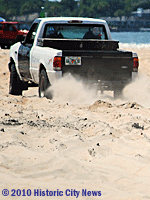 There are few topics more controversial in St. Johns County than driving on the beach; a Historic City News undercover report highlights one of the reasons why.
There are few topics more controversial in St. Johns County than driving on the beach; a Historic City News undercover report highlights one of the reasons why.
This is the first weekend after Labor Day and the summer crowds are headed home, the kids are back in school and the all-year residents and fall vacationers are out on the beach, taking advantage of a few more weeks of 90 degree, summer-like weather.
One of the most frustrating inhabitants for oceanfront homeowners and local residents, those who want to use the beach for relaxation and leisurely walks with their children and pets, is the vulture.
I’m not talking about the old world feathered kind with the crooked neck and uneasy attraction to the foul stench of death; I am talking about the bubba-truck driving kind with the crooked teeth and the willingness to help disaster along a little bit — especially when there’s a buck or fifty to be made.

I drive a JEEP Wrangler, and it’s not my first one. My grandfather first bought property in Vilano Beach subdivision when it was still a collection of sand dunes, sea oats, and winding sloughs. My parents built a home there after World War II that was featured in the local daily newspaper for its modern conveniences and quality construction, but if you saw the place today, you’d never know it.
I’ve enjoyed the good fortune to grow up on the same property as my prior generations, and, not surprisingly, I love the beach. However, along with what was in the 1950’s and 1960’s substantially unfettered access, I was taught by my parents to respect the beach, the fragile beach vegetation, and, the other families who shared the beach with me.
Even “back in the day”, when skeeters and dune buggys combed the beach, I knew that it was wrong to destroy the beach by cross-cutting the ruts used by other drivers. I knew that if you dug a hole, you filled it in before you left. And you never, ever “spun doughnuts” or drove recklessly — not just because you might get yourself or someone else hurt or killed, but because you made it impossible for others to drive the beach and have fun for themselves.
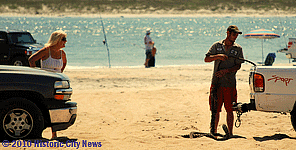
Along the way, probably sometime around when the protected least terns found us, the vultures found us.
They spend their morning tearing up the beach; then poise themselves overlooking their sand traps, waiting, with great anticipation, for the carnage that is inevitably to ensue.
This was one of those mornings.
The driver of a white Ford pickup truck, the one that comes standard with the baseball bat on the gun rack, is observed by a Historic City News reporter; who called me after she witnessed the driver repeatedly sticking and then un-sticking the truck in the soft sand around the south jetty at Porpoise Point.
The JEEP and I ride across the bridge to investigate further.
Sure enough, the driver has made a mess of the ruts that were otherwise sufficiently packed for vehicles to pass. Photographs were collected of the scene and I located the vehicle and its driver.
A woman and her small son, who had been previously enjoying their day at the beach, were stuck, although not too severely. According to the woman, she was forced to drive into the hazardous area to avoid fishermen and find a location safer for her son to swim.
Only moments after she got out to dig, the vulture in the white Ford swooped in for the kill. And, before you could say “Bob’s your uncle”, out pops a snatch rope that would make any self respecting wrecker driver jealous.
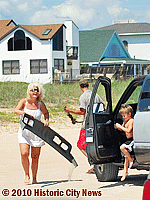
One of the greatest financial risks of using a vulture instead of a legitimate, licensed towing company is that the vulture doesn’t have to have any insurance. If they injure you or your car, good luck with the lawsuit.
This morning, the victim lost her bumper because the vulture didn’t tie down the tow rope properly to the frame of the victim’s vehicle. When you add the cost of that replacement to the cost of the tow, the vulture was very expensive.
I have witnessed any number of instances where a victim, lured into soft sand at the hands of a vulture, has ended up having to pay more than $75 or $100 to be freed — based on a “sliding scale” tied to how much the stranded vehicle is worth and how close it was to high tide.
I have seen snatch-ropes snap and people rushed to the hospital with injuries that may have cost them their leg or arm.
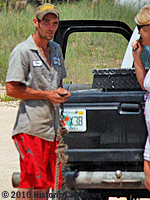
The consummate salesman, a vulture knows that they want to talk turkey, so to speak, after they have their victim’s vehicle unstuck, but still on the tow rope.
Of course the victim’s desperation while they are still knee-deep in sand makes it easier to talk about charging more money, but, let’s just say that the best trades are made after the grateful damsel in distress is rescued by her knight in shining armor.
According to the victim in this case, who, by the way, works in the court system, the vulture picked up on the single-mom stranded with her young son situation as soon as he pulled up to the scene.
She told us that she could tell when somebody was telling her “BS” and she was on to this guy as soon as he started with the “I’m going through a divorce” and the “I just lost my job” lines. Nonetheless, she did give him money for towing her out and she told us that she realizes why it was wrong. “I could have called AAA,” the victim said. “I didn’t really think about what these guys were out here doing.”
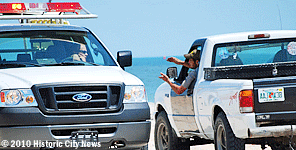
We spoke to a member of the St. Johns County Fire Rescue who was serving as a lifeguard today and explained what was going on with the vulture.
He knew the difficulty of catching these vultures because they strike and flee so quickly. One of the weapons in his arsenal, though, is a county ordinance that allows Fire Rescue personnel to order anyone to “leave the beach”. If so ordered, a deputy can be summoned to arrest the violator.
Today, this vulture was ordered to leave, but, he will likely come back again next weekend. Or, maybe he’ll just hold on until after the lifeguards leave in October or until he gets through that nasty divorce and back on the job again.
Photo credits: © 2010 Historic City News staff photographer
Discover more from HISTORIC CITY NEWS
Subscribe to get the latest posts sent to your email.


Comments are closed